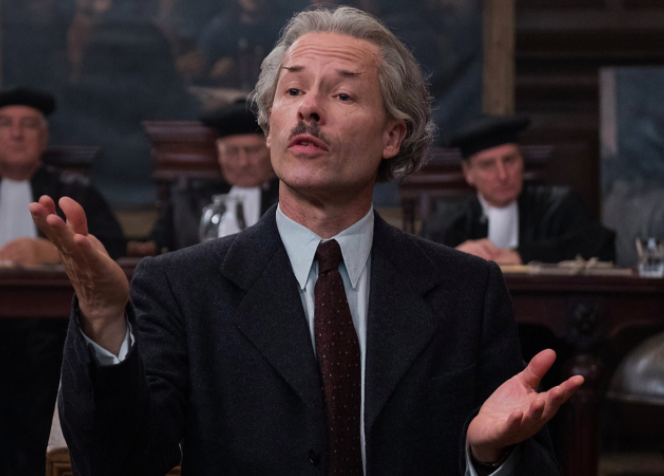“The Last Vermeer” Is a Study of Art in All Its Vibrant Colors, including Gray
By Sue Weston and Susan Rosenbluth – Two Sues on the Aisle
The discovery of private paintings, many of them masterpieces that had belonged to wealthy Jews throughout Europe in the years before World War II and then stolen, looted, and secreted away by Nazi officials, is a story that has piqued the interest of writers, filmmakers, and journalists. To the list of those intrigued, now add producer Dan Friedkin, who makes his directorial debut in “The Last Vermeer,” a film about an artist, art lover, and art dealer who managed to ply all his gifts in a scheme to outwit none other than Nazi Field-Marshal Hermann Goering.
Based on a true story from the award-winning book, “The Man Who Made Vermeers” by Jonathan Lopez,
Friedkin’s film begins in 1945 when the Allied Provisional government in Amsterdam launched an investigation to discover how some great works of art, especially by the 17th-century Dutch Master Johannes Vermeer, were found in a Nazi freight car buried in the countryside outside the city.
The investigation was led by Captain Joseph Piller (Claes Bang), a former Dutch-Jewish tailor and jazz pianist who joined the Resistance in an effort to protect his family and served with such honor, his superiors and the Allied forces took notice. Although not mentioned in the film, the real Joseph Piller made a name for himself in the Resistance by finding hiding places for Jewish children from the cities and keeping them safe in the Dutch countryside. In 1942, his assignment expanded to rescuing Allied airmen shot down over German-occupied territory and spiriting them across the frontlines to safety.
The Mission
The film opens as Piller is given his mission: to discover who originally owned the Vermeer in question and who sold the work—priceless because there still are only 36 known paintings by Vermeer in existence—to Goering. The offense, collaborating with the enemy during wartime, was both a national offense against the Dutch people and a war-crime punishable by death.
While neither a trained investigator nor an expert in art history, Piller, the moral center of the film, takes to his assignment with understandable zeal. He simply hates Nazi collaborators and wants them caught, tried, and punished. It takes no stretch of the imagination to understand why, in the film, Piller is able to watch without emotion as Dutch Nazi collaborators face firing squads in public squares. He, like the cheering Dutch people, wants revenge.
To help in the investigation, Piller calls on his former Resistance comrade-in-arms (Roland Møller) a loyal if somewhat dense freedom fighter.
They are led very quickly to Han van Meergen (the riveting Guy Pearce), a once-promising art student whose career was derailed by critics, decrying his work as tired and derivative. To remain part of the heady art world, he continued to paint and, more importantly, became a highly successful dealer, but unbeknownst to many of his rich and famous clients, the works he sold as masterpieces by the great painters of the Dutch Golden Age were actually forgeries done by himself. He learned the secrets of aging the materials and replicated the masters’ styles so well that some of Europe’s most prestigious critics and experts—the very authorities who had passionately dismissed him and his talents—accepted his forged paintings as not only genuine, but exquisite.

Han van Meergen (the riveting Guy Pearce)
Elusive Truth
The film’s casting, acting, and set design are impeccable, combining to pull the story together. The themes of greed, vanity, power, corruption, talent, and moral integrity and confusion merge by integrating Piller’s uncompromising, all-consuming need to discover the truth, complicated by van Meergen’s almost flippant desire to force the investigator to solve the riddle himself. Even though he may face a firing squad, Mr. Pearce’s van Meergen is unflappable and, only reluctantly, will ever ask for help (although he will demand art supplies).
Flamboyant but logical, narcissistic but rational, wealthy but generous to a fault, and witty even when faced with almost certain doom, van Meergen has managed throughout the war to continue his lavish lifestyle which stands in stark contrast to the backdrop of devastation all around him.
Muddying the water for both Piller and van Meergen are Dutch government officials, many of them professional investigators and jurists, looking to take the reins from the Allied powers in this quest to catch and punish Nazi collaborators.
Piller, who refers to Justice Minister Alex De Klerks (August Diehl) as overseeing the “Ministry of Convenience,” worries they might want to free collaborators with connections and money. Van Meergen knows if he can’t buy his way out of his difficulties, he faces a bleak choice: confess to forgery or let them execute him as a collaborator.
As Piller grows increasingly convinced of van Meergen’s innocence, the investigator finds himself in the unlikely position of fighting to save the forger’s life.
Ironic Ambiguities
Throughout the film, Piller struggles with his demons from the war, especially his wife’s position as an assistant to a high-ranking German. The job enabled her to feed information to the Resistance, but it also meant her photograph appeared showing her enjoying one of van Meergen’s hedonistic soirées on the arm of a Nazi officer.
Van Meergen, on the other hand, struggles with the capriciousness of art critics who all too often judge their subjects not on the basis of talent, but on opinion, which greatly influences the price the would-be artist’s work can command and the prestige it enjoys. Van Meergen understands all too well that when the world believed his forgery was really a Vermeer, it was priceless. The exact same work was virtually worthless as a van Meergen.
Even in the riveting courtroom scenes, which dominate the last third of the film, the hotly sought verdict seems eager to balance the value of a human life against a priceless Dutch masterpiece.
To the end, Piller, the Dutch public, and the viewer are never quite sure if the forger, like his forgeries, is what he seems: A self-serving, brilliant, seductive, and completely amoral Nazi collaborator; a victim, like Piller’s wife, who did what was necessary to survive; or a Dutch patriot who set out to swindle one of the most powerful figures in the Nazi party to the tune of 1.5 million guilders, making the forgery bought by Goering the most expensive painting in the world to that time.
As van Meergen tells Piller in the film: “In life, as in art, it’s always better not to spoil the surprise.”
“The Last Vermeer” proves that we are deeply affected by art in all its vibrant colors, including gray.

Girl with a Pearl Earring – Vermeer
***
Two Sues on the Aisle bases its ratings on how many challahs it pays to buy (rather than make) in order to see the play, show, film, exhibit, or tour being reviewed.
The Last Vermeer” received 5 challahs






